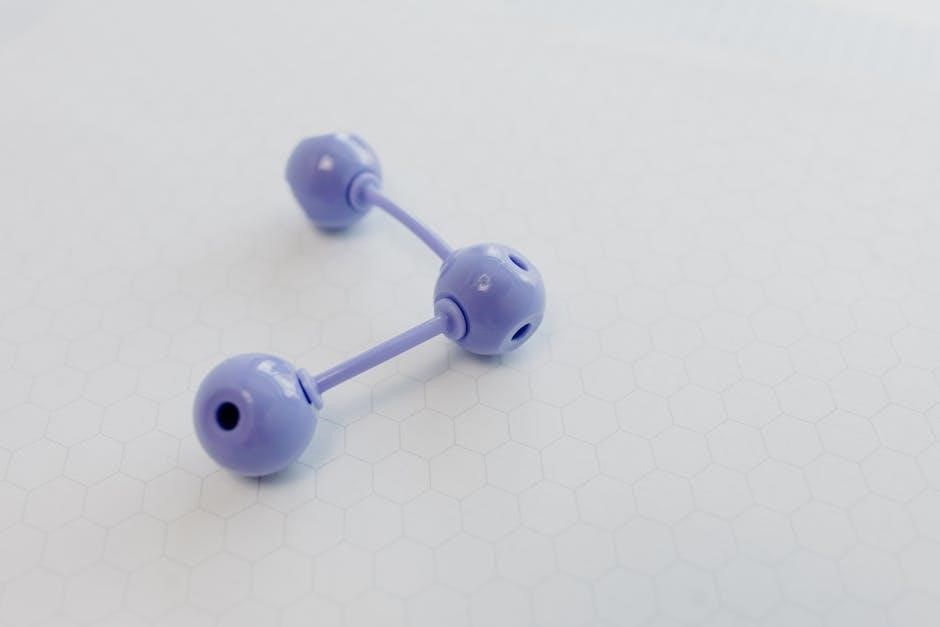plastic guide
- Published
- in Guide
Plastic Guide: Understanding Types, Uses, and Recycling
Plastic is an incredibly versatile material, but understanding its types, uses, and recycling processes is crucial. This guide explores plastic composition, common types like PET and HDPE, and the importance of recycling to mitigate environmental impact. Learn sustainable alternatives and make informed choices about plastic consumption and disposal.
What is Plastic? Composition and Properties
Plastic is a manufactured material primarily derived from natural gas, oil, and coal. It’s composed of synthetic polymers, which are long, repeating chains of molecules chemically bonded through human processes. These polymers, while sometimes found in nature like cellulose, are predominantly created synthetically for plastic production.
The specific properties of plastic vary depending on the structure of these polymers. Different arrangements result in diverse physical characteristics, enabling a wide range of applications. Plastics are known for being lightweight, durable, and easily processable, making them suitable replacements for traditional materials like wood, metal, and ceramics in various industries.
However, it’s important to recognize that “plastic” isn’t a monolithic entity. It encompasses a broad spectrum of materials, each with distinct properties and uses. These variations influence their recyclability, health hazards, and potential alternatives, including bioplastics. Understanding the complexities of plastic, including its composition and properties, is essential for informed decision-making regarding its use and disposal.
Common Types of Plastics: An Overview
Navigating the world of plastics requires understanding the different types available. Plastics are categorized into seven main types, each distinguished by unique properties, uses, and recycling characteristics. These types are often identified by a number inside a recycling symbol, which aids in sorting and processing.
The most commonly encountered plastics include Polyethylene Terephthalate (PET), known for its use in beverage bottles and food containers; High-Density Polyethylene (HDPE), often found in milk jugs and detergent bottles; and Polyvinyl Chloride (PVC), utilized in piping, siding, and cable insulation. Other prevalent types are Low-Density Polyethylene (LDPE), commonly used in plastic bags; Polypropylene (PP), found in containers and packaging; and Polystyrene (PS), used in disposable cups and packaging foam.
Each plastic type offers specific properties that make it suitable for different applications. For example, PET is lightweight and shatterproof, while HDPE is incredibly resistant. Understanding these characteristics is crucial for selecting the right plastic for a particular purpose and for ensuring proper recycling practices. Recycling rates vary among these types, affecting the value and market size for recovered materials.
Polyethylene Terephthalate (PET or PETE): Properties and Uses
Polyethylene Terephthalate, commonly known as PET or PETE, is a widely used thermoplastic polymer renowned for its clarity, strength, and recyclability. It is created from petroleum-based substances and molded under pressure and heat, resulting in a material with distinct physical and mechanical properties. PET is lightweight yet shatterproof, making it ideal for various packaging applications, including beverage bottles, cooking oil containers, and food jars.
One of PET’s key properties is its high tensile strength, which ensures durability and resistance to deformation. It is also chemically inert, meaning it does not react with the contents it holds, preserving the quality and safety of packaged goods. Furthermore, PET exhibits excellent gas barrier properties, preventing the escape of carbonation from carbonated drinks.
PET is among the most readily recyclable plastics, often transformed into fibers for clothing, new containers, or other useful products. Recycling PET helps reduce waste, conserve resources, and lower the environmental impact associated with plastic production. Its versatility and recyclability make PET a preferred choice for numerous consumer and industrial applications.
High-Density Polyethylene (HDPE): Properties and Uses
High-Density Polyethylene (HDPE) is another common thermoplastic known for its exceptional strength-to-density ratio. It stands out due to its high impact resistance, chemical resistance, and ability to withstand extreme temperatures. HDPE is typically produced from petroleum, and its properties make it suitable for a wide array of applications, particularly in packaging and construction.
HDPE is widely used for producing rigid containers such as milk jugs, detergent bottles, shampoo bottles, and recycling bins. Its durability ensures these containers can withstand repeated use and resist cracking. In construction, HDPE finds application in piping for plumbing, drainage systems, and agricultural uses. Its chemical resistance prevents corrosion and degradation when exposed to various substances.
HDPE is also recyclable, making it an environmentally responsible choice. Recycled HDPE can be transformed into new products like plastic lumber, playground equipment, and more containers. Recycling HDPE reduces landfill waste and conserves valuable resources. Its combination of strength, durability, and recyclability makes HDPE a preferred material for diverse industries seeking reliable and sustainable solutions.

Polyvinyl Chloride (PVC or V): Properties and Uses
Polyvinyl Chloride (PVC), also known as vinyl, is a widely used thermoplastic polymer prized for its versatility and durability. PVC is known for its inherent flame-retardant properties, making it a safe choice for various applications. It is also resistant to chemicals, moisture, and abrasion, which enhances its longevity and suitability for demanding environments.
PVC is commonly found in construction for piping, siding, window frames, and roofing. Its resistance to weathering and corrosion makes it an ideal material for these exterior applications. It is also used in electrical cable insulation, providing protection against electrical hazards. In consumer products, PVC is utilized for credit cards, blister packaging, and protective wraps.
Despite its widespread use, PVC recycling presents challenges due to its chemical composition. However, efforts are underway to improve PVC recycling technologies. Recycled PVC can be used to manufacture new products, such as flooring, mats, and automotive components. While PVC offers numerous advantages, its environmental impact and recyclability are important considerations for sustainable practices.
Low-Density Polyethylene (LDPE): Properties and Uses
Low-Density Polyethylene (LDPE) is a thermoplastic polymer characterized by its flexibility and toughness. LDPE is known for its excellent impact resistance, moisture resistance, and chemical inertness, making it suitable for a wide range of applications. LDPE’s lower density and branched molecular structure give it distinct properties compared to other polyethylenes.
LDPE is commonly used in film applications, such as plastic bags, food packaging films, and agricultural films. Its flexibility and moisture barrier properties make it ideal for protecting food and other goods; LDPE is also used in squeeze bottles, toys, and coatings for paper and cardboard.
While LDPE is recyclable, its recycling rates are lower compared to PET and HDPE. However, LDPE recycling is still important to reduce plastic waste and conserve resources. Recycled LDPE can be used to manufacture new products, such as plastic lumber, compost bins, and trash cans. Understanding the properties and uses of LDPE is essential for promoting proper recycling and reducing environmental impact.
Polypropylene (PP): Properties and Uses
Polypropylene (PP) is a versatile thermoplastic polymer known for its strength, heat resistance, and chemical resistance. PP is a rigid and crystalline plastic, but it can also be produced in a flexible form. Its ability to withstand high temperatures makes it suitable for applications requiring sterilization.
PP is widely used in packaging, including food containers, bottles, and caps. Its chemical resistance makes it ideal for storing detergents, cleaning agents, and other household chemicals. PP is also used in automotive parts, textiles, and medical devices.
PP is recyclable, and its recycling rate is increasing. Recycled PP can be used to manufacture a variety of products, including automotive parts, garden furniture, and storage containers. Understanding the properties and uses of PP is crucial for promoting its proper recycling and reducing plastic waste. By choosing products made from recycled PP, consumers can contribute to a more sustainable future. PP’s versatility and recyclability make it a valuable material in various industries.

Polystyrene (PS): Properties and Uses
Polystyrene (PS) is a versatile thermoplastic polymer that exists in both solid and foam forms. Its rigid form is commonly used in products requiring clarity and stiffness, such as food containers, lids, and disposable cutlery. Expanded polystyrene (EPS), commonly known as Styrofoam, is lightweight and provides excellent insulation, making it suitable for packaging fragile items and insulating buildings.
PS is cost-effective and easily molded into various shapes. However, its brittle nature makes it prone to cracking and breakage. PS is commonly used in disposable cups, plates, and takeout containers. Its low melting point limits its use in high-temperature applications.
The recyclability of PS varies depending on the form and local recycling infrastructure. Expanded polystyrene (EPS) is often challenging to recycle due to its bulky nature and contamination. Recycling PS can reduce landfill waste and conserve resources. Understanding the properties and uses of PS is crucial for promoting responsible consumption and disposal practices. Choosing alternatives to PS and supporting recycling initiatives can minimize its environmental impact.

Other Plastics: A Brief Overview
Beyond the common plastics like PET, HDPE, PVC, LDPE, PP, and PS, a variety of other plastics serve specific purposes across diverse industries. These include Polycarbonate (PC), known for its high impact resistance and transparency, often used in safety glasses and electronic components. Acrylic (PMMA) is another transparent plastic valued for its weather resistance and used in signage and displays.
Polyurethane (PU) is versatile, available as flexible foams, rigid solids, and coatings, finding applications in furniture, insulation, and automotive parts. Polyamide (Nylon) boasts high strength and abrasion resistance, making it suitable for textiles, gears, and bearings.
Acrylonitrile Butadiene Styrene (ABS) combines toughness, rigidity, and chemical resistance, commonly used in automotive parts and electronic housings. These “other” plastics often possess unique properties tailored to demanding applications. However, recycling these materials can be more complex due to their diverse compositions and lower volumes. Understanding their specific properties and uses is essential for proper disposal and exploring potential recycling options where available. Innovations in recycling technologies are continuously expanding the possibilities for managing these diverse plastic streams.

Plastic Recycling: Processes and Benefits
Plastic recycling is a critical process for mitigating the environmental impact of plastic waste. It involves several key steps, beginning with collection and sorting. Plastics are separated by type (PET, HDPE, PVC, etc.) to ensure compatibility during reprocessing. After sorting, the plastics are cleaned to remove contaminants like labels and residues.
The cleaned plastics are then shredded into small flakes or pellets. These flakes can be melted down and reformed into new products, such as bottles, containers, or even fibers for clothing. Alternatively, some plastics can be chemically recycled, breaking them down into their original monomers to create virgin-quality plastic.
The benefits of plastic recycling are numerous. It conserves natural resources by reducing the need for new raw materials like oil and natural gas. Recycling also saves energy compared to producing new plastics, lowering greenhouse gas emissions. Furthermore, it reduces landfill waste, minimizing pollution and conserving valuable land space. Recycling helps to create a circular economy for plastics, promoting sustainability and resource efficiency. Increased recycling rates are essential to address plastic pollution and protect the environment.
Environmental Impact and Sustainable Alternatives
The environmental impact of plastics is a significant concern due to their persistence and widespread use. Plastics can take hundreds, even thousands, of years to biodegrade, leading to accumulation in landfills and oceans. This accumulation results in habitat destruction, harm to wildlife through entanglement and ingestion, and the release of harmful chemicals into the environment. Microplastics, tiny plastic particles, further exacerbate the problem, entering the food chain and potentially impacting human health.
To mitigate these issues, sustainable alternatives to traditional plastics are being developed and adopted. Bioplastics, derived from renewable resources like cornstarch or sugarcane, offer a more biodegradable option. However, their production and disposal also have environmental considerations that need careful management. Other alternatives include using materials like glass, metal, and paper for packaging, as well as reducing overall plastic consumption through reusable containers and shopping bags. Promoting a circular economy with improved recycling technologies and responsible waste management practices is essential to minimize the environmental footprint of plastics. Consumer awareness and responsible usage play crucial roles in reducing plastic pollution and creating a more sustainable future.
